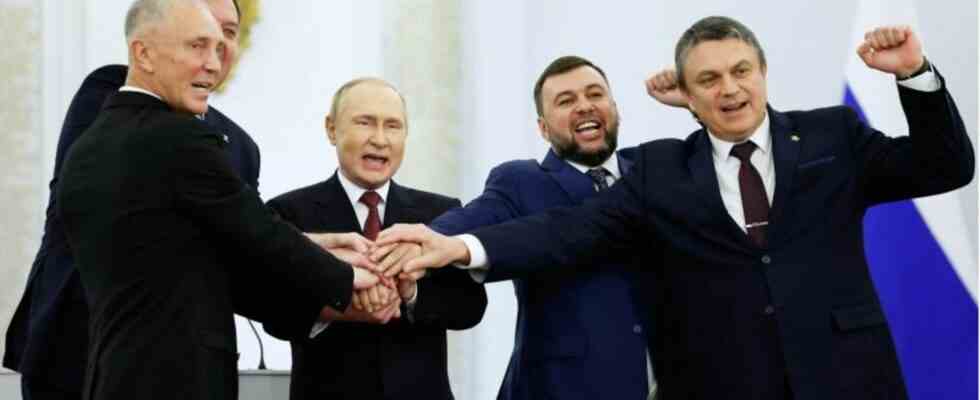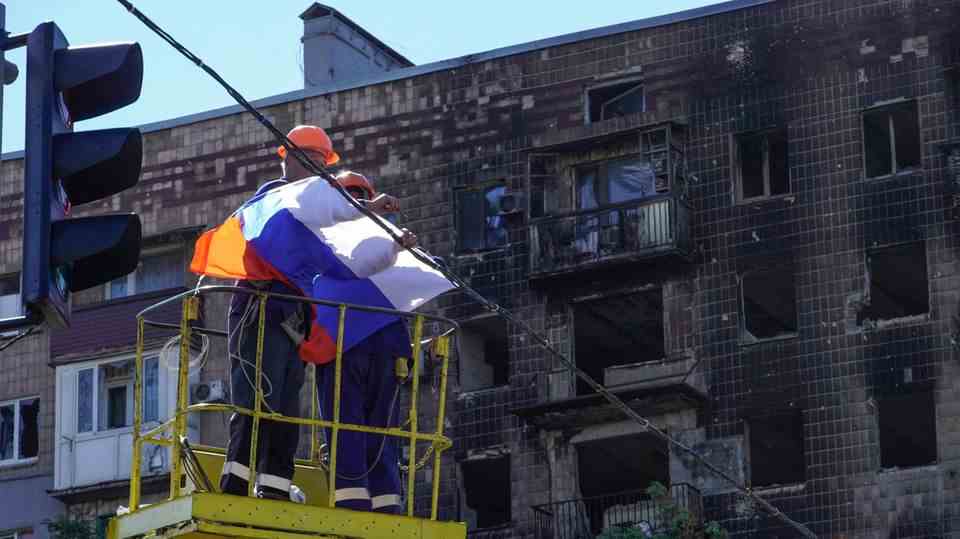Ukraine war
How things could continue in the areas annexed by Russia. Seven Scenarios
Illegal unity: Moscow-appointed representatives of the Kherson regions Vladimir Saldo and Zaporizhia Yevgeny Bki, Russian President Vladimir Putin, Donetsk separatist leader Denis Pushhilin and Luhansk separatist leader Leonid Passechnik shake hands
© Dmitry Astakhov / Sputnik / AFP
The four occupied Ukrainian territories have belonged to Russia since Friday afternoon – at least from the Kremlin’s point of view. Kiev’s troops will continue to try to recapture them. With what consequences? Seven possible scenarios.
An unmistakable countdown to the “signing of the treaties on the accession of new regions to the Russian Federation” ran down on television. Large rallies are taking place on Red Square and other corners of the capital Moscow, and recruiters for mass events have been luring people with rubles for days to participate. The sole purpose of the huge show is to fool the country (and probably the leadership) into gigantic enthusiasm for the annexation of the occupied Ukrainian territories. The highlight of the celebrations: the speech by President Vladimir Putin. It was full of sometimes bizarre tirades against the West, but made only vague hints about the war itself.
Next violent border shift
With the annexation of the four occupied regions of Donetsk, Luhansk, Cherson and Zaporizhia, Russia is for the first time since annexing the Black Sea peninsula of Crimea in 2014, using force to move borders in Europe. Neither the invasion of the neighboring country, nor the referenda or the annexation are covered by international law. Alone: There is no party that could or would punish Russia’s violations. However, Ukraine has the right to self-defense and is demanding supplies of heavy weapons from the West. However, the leadership in Moscow has already made it clear that it regards all attacks on the occupied territories as an attack on its territory – and does not even shy away from a reaction with nuclear weapons.
So what happens now if Russia keeps its hand on eastern and southern Ukraine? Seven Scenarios:
- Russia declares that all war aims have been achieved with the annexation and ends further fighting in Ukraine. The country’s President, Volodymyr Zelenskyj, however, sticks to his announcement that he wants to reconquer all areas. The war goes on as before.
- Despite all efforts, Russia has not yet managed to conquer the entire Donetsk region. Russian troops have so far controlled 58 percent, but the remaining 42 percent are now officially joining Russia, according to the Russian account. Complete control of Donetsk is one of the Kremlin’s stated minimum goals. In order to be able to hold the region, Putin is having 300,000 reservists drafted into the controversial partial mobilization. At least there the fighting will continue.
Families affected by Putin’s mobilization
- The fighting in the occupied areas is declining significantly, but the mood among the population is rather depressed. Billions are needed for reconstruction, and at the same time Western sanctions are putting pressure on the Russian economy. In addition, many families are directly affected by the war due to the partial mobilization. This could potentially affect those Ukrainians who have recently acquired Russian citizenship. In the areas in Luhansk and Donetsk controlled by pro-Russian separatists, Ukrainians have been fighting against Ukrainians for eight years.
- A negotiated solution, which many critics of the war are calling for, is de facto off the table with the annexation of the occupied territories. Vladimir Putin has tied his political fate to the campaign: He has repeatedly described Ukraine as part of the “Russian heartland,” even though he has now emphasized that he does not want to revive the Soviet Union. Having to give up “one’s” new territory is unthinkable in this worldview. But Ukraine is also unwilling to accept territorial losses or see them as a bargaining chip. Nonetheless, Putin made an “offer” to his opponent in his speech: “We call on the Kiev regime to stop the shelling and all hostilities immediately and to return to the negotiating table.”
Is Russia Using Nuclear Weapons?
- The horror scenario: Russia carries out its nuclear bomb threat and uses nuclear weapons. In his speech he touched on the subject only marginally. Presumably only a few warheads would be used. They could be detonated over the Black Sea, over parts of Ukraine or in sparsely populated areas. The aim would be to force the government in Kyiv to capitulate. The West has not yet made clear how it would react to a tactical nuclear strike. However, the US government has indicated that it will react decisively. Otherwise, other countries like China could be tricked ” into believing that nuclear weapons will help them achieve their goals without serious consequences,” says Matthew Kroenig of the Scowcroft Center for Strategy and Security in the US. A conceivable reaction would be to conventionally attack Russian forces or the military base from which the nuclear attack emanated.
- The “Rasputitsa” (loosely translated as Mud Time) is an aide Russia has relied on many times in past battles, and possibly again this time. In autumn, when the ground gets wet and muddy, it becomes difficult for attacking troops to advance, an advantage for the defenders. With the help of the newly drafted soldiers, the Kremlin could also count on repelling the Ukrainians until “pathlessness” appears on the battlefield. After the spring of next year, the Russian army could then start its offensive again, rested and reorganized.
The Ukraine war that never ends
- “Saving” the war over the winter and prolonging it is considered by many experts to be almost the most likely scenario. The idea behind it: wear down the Ukrainians with a war of attrition. Hardly anyone doubts that Russia, at least in principle, has more resources and therefore more staying power than Ukraine. Military expert Gustav Gressel of the think tank Europe Council on Foreign Relations fears that the war “is likely to last for many years, although violence is likely to subside over time.” In a study he writes that Russia is betting on slow progress on the ground and expects that rising energy prices and the wave of refugees will weaken Western public support for Ukraine.”
Sources: DPA, AFP, European Council on Foreign Relations, ND, Scowcroft Center for Strategy and Security



